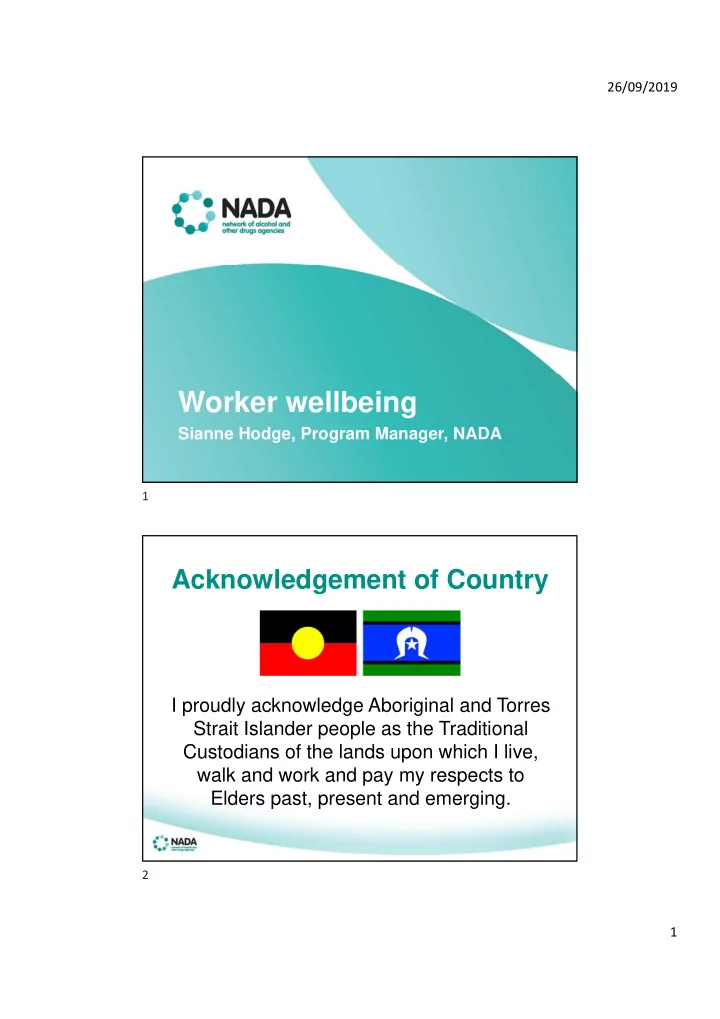

26/09/2019 Worker wellbeing Sianne Hodge, Program Manager, NADA 1 Acknowledgement of Country I proudly acknowledge Aboriginal and Torres Strait Islander people as the Traditional Custodians of the lands upon which I live, walk and work and pay my respects to Elders past, present and emerging. 2 1
26/09/2019 Context 3 Context 4 2
26/09/2019 Context 5 Context 6 3
26/09/2019 Context 7 Context 8 4
26/09/2019 Context 9 Context 10 5
26/09/2019 Context 11 Context 12 6
26/09/2019 Context 13 Context 14 7
26/09/2019 Context 15 Context 16 8
26/09/2019 Worker wellbeing (Harvey et al 2015) 17 Workplace wellbeing Relative Intervention Goal Example strategies and corresponding activities effectiveness level Most Primary Promotion: Reduce job demands Increase time or other resource effective allocation to complete job tasks Eliminate or reduce job- related stressors and Provide breaks from client-based work increase protective factors Increase job control Increase worker involvement in work planning and decision making Assess and integrate employee needs into planning of work schedules Strengthen relationships and Assess and integrate employee needs supports to optimise supervisory social support Create clear promotion pathways Secondary Protection: Alter responses to job Provide mindfulness training stressors Alter perceptions and Improve coping and resilience Provide stress management training responses to job-related stressors Detect stress symptoms and Conduct wellbeing checks and assess intervene early and respond to results at a group level Tertiary Support: Treat job-related stress illness Provide access to counselling and EAP Support workers to return to Include modification of job stressors in Provide support to workers Least work RTW plans experiencing job-related effective illness (adapted from LaMontagne & Keegel 2010) 18 9
26/09/2019 Background and methods 19 Project description • In 2017, NADA commissioned NCETA to survey the AOD workforce in NSW. • Key research questions included: i. What is the demographic and professional profile of NGO AOD workers in NSW? ii. To what extent are they supported to perform their roles? iii. To what extent are they satisfied working in the NGO AOD sector? (Kostadinov et al, 2018) 20 10
26/09/2019 Methods Recruitment • NGO AOD workers in NSW • Snowball sampling method Data collection • Customised online survey • Hosted on SurveyMonkey • Administered Sep - Nov 2017 21 Methods (Roche et al 2018) 22 11
26/09/2019 Results 23 Results 24 12
26/09/2019 Results 25 Results 26 13
26/09/2019 Results 27 Results 28 14
26/09/2019 Results 29 Results 30 15
26/09/2019 Results 31 Results 32 16
26/09/2019 Results 33 Results 34 17
26/09/2019 Results 35 Results 36 18
26/09/2019 Results 37 Results 38 19
26/09/2019 Results 39 Results 40 20
26/09/2019 Results 41 Results 42 21
26/09/2019 Results 43 Results 44 22
26/09/2019 Summary 45 Findings • Wellbeing levels were relatively high, and burnout was very uncommon. • Respondents were typically satisfied with opportunities for growth, team cohesion, levels of social support, feedback, and role clarity. • Job and employment-related factors that warrant greater attention included job security, remuneration, autonomy, staffing, workload, stress, communication, access to supervision, and leadership quality. 46 23
26/09/2019 Reflection 47 Worker self-care check • Designed to help workers identify whether there’s is an imbalance in the areas in which they practice self-care • Asks respondents to look for patterns in your responses. Are you more active in some areas but ignore others? Were there activities on the list that made you think ‘I’ve never thought of that’? 48 24
26/09/2019 Worker self-care check 49 Where are you focusing your efforts? Relative Intervention Goal Example strategies and corresponding activities effectiveness level Most Primary Promotion: Reduce job demands Increase time or other resource effective allocation to complete job tasks Eliminate or reduce job- related stressors and Provide breaks from client-based work increase protective factors Increase job control Increase worker involvement in work planning and decision making Assess and integrate employee needs into planning of work schedules Strengthen relationships and Assess and integrate employee needs supports to optimise supervisory social support Create clear promotion pathways Secondary Protection: Alter responses to job Provide mindfulness training stressors Alter perceptions and Improve coping and resilience Provide stress management training responses to job-related stressors Detect stress symptoms and Conduct wellbeing checks and assess intervene early and respond to results at a group level Tertiary Support: Treat job-related stress illness Provide access to counselling and EAP Support workers to return to Include modification of job stressors in Provide support to workers Least work RTW plans experiencing job-related effective illness (adapted from LaMontagne & Keegel 2010) 50 25
26/09/2019 Translating findings into practice 51 Publications 52 26
26/09/2019 Resources 53 Acknowledgements 54 27
26/09/2019 Project partners 55 Questions 56 28
26/09/2019 Contact me Sianne Hodge Program Manager, NADA P: 0410 303 616 E: sianne@nada.org.au W: www.nada.org.au 57 29
Recommend
More recommend